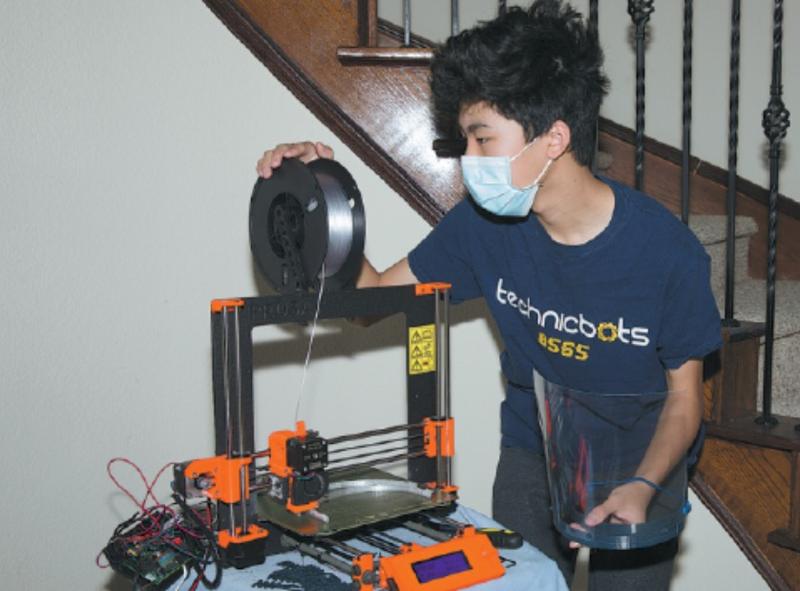 Max Fan, a member of the high school robotics team Technicbots, makes face shields using 3D printing technology at home. (TIAN DAN / XINHUA)
Max Fan, a member of the high school robotics team Technicbots, makes face shields using 3D printing technology at home. (TIAN DAN / XINHUA)
HOUSTON - A community health care center in Texas has taken delivery of 70 face shields and 300 ear guards. The donation was all the more special because the items were made by high school students using 3D printing technology.
Founded in 2009 in the city of Plano, the team has taken part in contests organized by For Inspiration and Recognition of Science and Technology, an international youth organization
"The project started in the middle of March after the spring holiday," Wang Fang, the leader of a high school robotics team known as Technicbots, told Xinhua in an interview.
Technicbots initiated the 3D printing of personal protective equipment for local health workers. Founded in 2009 in the city of Plano, the team has taken part in contests organized by For Inspiration and Recognition of Science and Technology, an international youth organization.
Concerned about the shortage of protective equipment for frontline medical workers in the COVID-19 outbreak, many Chinese-American groups in Texas have raised funds. The 10 Chinese-American students in the Technicbots team were also encouraged to make their own contributions.
"We noticed that companies from the United States and the Czech Republic have released models of PPE using 3D printing and we used them as our original models," Wang said, adding that the team has been working on 3D printing over recent years.
The team focused on the face shields and ear guards, with the latter easing the discomfort for health workers from long periods of wearing masks.
After finishing a few samples, the team contacted clinics in need for testing and got feedback before modifying the models. "It took a few weeks to finalize the models after doctors and nurses were absolutely satisfied with the products," said Wang.
Technicbots has carried out volunteer work, such as at summer camps, to introduce robotics to more students. But using these skills to help the community was new to the teenagers.
"When hosting camps we would have months to prepare the curriculum and we would only have to meet once a week to get things done," team member Austin Liu said. "But since the situation is different now, we really had to work together to meet every day and things are really more urgent than is the case with some of the other volunteer work."
Virtual meetings
Setting up the production line was not easy amid social isolation. Unable to meet, the students and their leader have virtual meetings every afternoon, reporting progress and assigning new tasks. Suddenly, their homes have been transformed into factories, warehouses and meeting rooms.
ALSO READ: Youth play role to help Africa beat pandemic
Working under time pressures and communicating with different groups made the process stressful at first, but the students quickly adjusted to overcome the difficulties.
"The rhythm was so quick," said team member John Dunbar. "But I think by now everything has fallen into place."
Team member Melody Hu said that, in order to become more efficient, the 10 team members were divided into nine groups. From making and assembling to sanitizing and packaging, from request processing to material researching, the whole production line was run by the students themselves supervised by the team leader and their parents.
So far, the team has delivered nearly 600 face shields and around 1,300 ear guards to 20 hospitals and clinics, receiving positive responses from medical workers.
The latest recipient was the North Central Texas Community Health Care Center.
"This is a truly gift that will help our staff that are treating patients. It's a great thing for us to have," said the center's Aaron Goodwin when receiving the equipment a few days ago.
With more and more orders, the team is now working with four other robotic teams and a professor from the University of Texas. "To sustain these efforts, we recently started a fundraising effort and so far we have raised US$4,415," Hu said.
The students have grown in all aspects through this process. "One way this experience has impacted me is that I have learnt how to work with other people," team member Audrey He said. "Aside from collaborating with other robotics teams, we're also learning how to communicate with medical workers."
READ MORE: 3D printing injects future into medical industry
Applying what they have learned to serve the community also gives students an unprecedented sense of pride.
"This volunteer work has given me a bit more responsibility because we know that we're doing this to help people in the medical field to save lives," team member Max Fan said. "I'm proud of myself."


